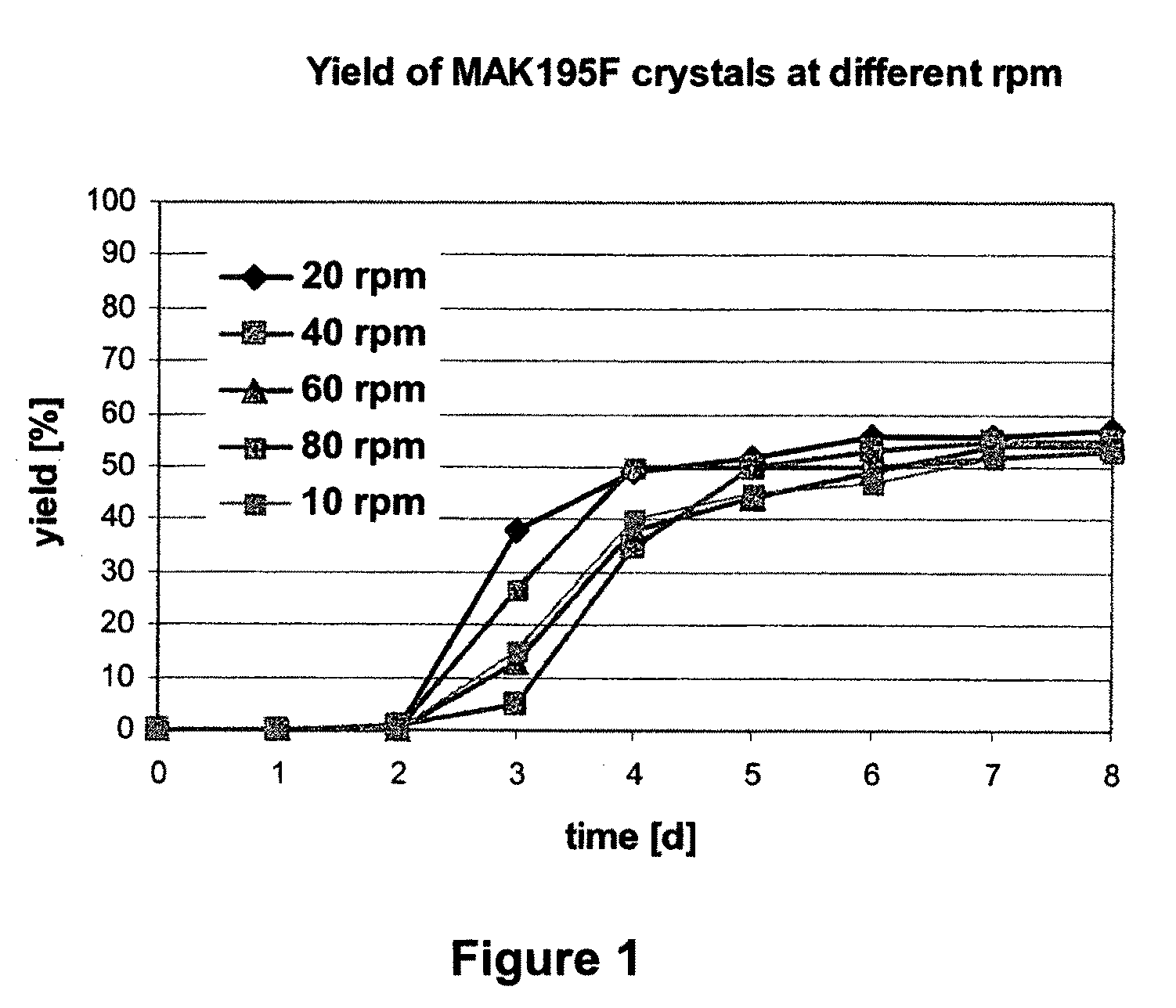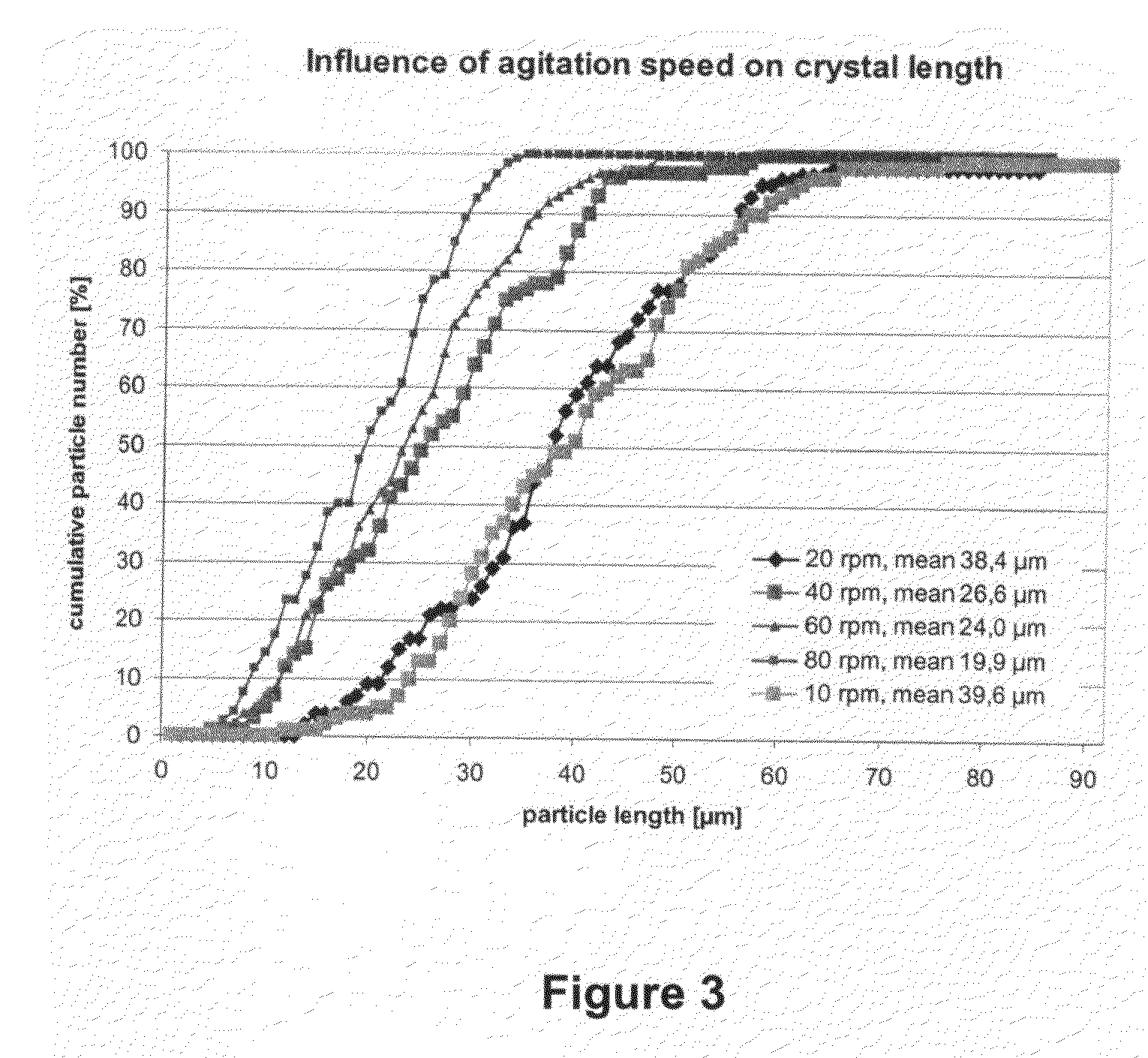Compositions and methods for crystallizing antibodies
a technology of crystallizing antibodies and compositions, applied in the direction of antibody medical ingredients, single crystal growth details, capsule delivery, etc., can solve the problems of preventing compliance with safety and stability requirements, affecting the and affecting the syringeability of antibodies, so as to achieve the effect of increasing the overall yield of antibody or antibody fragment crystallization
- Summary
- Abstract
- Description
- Claims
- Application Information
AI Technical Summary
Benefits of technology
Problems solved by technology
Method used
Image
Examples
example 1
Initial Screening of Conditions in Vapor Diffusion Mode
[0216]MAK195F was buffered into a 20 mM HEPES / 150 mM sodium chloride buffer at pH 7.4. The protein concentration was adjusted to 10 mg / mL. Using the Hydra II crystallization robot, 96 well Greiner plates were set up at ambient temperature, using several commercially available crystallization screens. The protein solution and the crystallization agent were mixed in a ratio of 1:1. Following screens were used: Hampton Crystal Screen 1 & 2 (Hampton Research), Wizard Screen I & II (Emerald BioStructures), Hampton Index Screen (Hampton Research), Jena Screens 1-8 (Jena Bioscience). After addition of protein to a crystallization agent well known in the art (one drop per condition), the plates were sealed with Clearseal film and stored at ambient temperature. Microscopy of the drops was performed multiple times during the following seven days. The conditions were classified into clear drops, drops containing random precipitation, drops...
example 2
Hanging Drop Vapor Diffusion Using Hampton PEG / Ion Screen
[0240]MAK195F was buffered into a 20 mM HEPES / 150 mM sodium chloride buffer at pH 7.4. The protein concentration was adjusted to 10 mg / mL. Greased VDX plates and circular siliconized glass cover slides were used. 1 mL of each of the 48 buffer formulations was pipetted into a well. Around 1 μL of protein sample was pipetted onto a cover slide and subsequently mixed with around 1 μL of reservoir solution of a particular well. The well was sealed with the inverted cover slide, generating a hanging drop experiment. The plates were stored at ambient temperature. Microscopy of the drops was performed multiple times during the following seven days. The conditions were classified into clear drops, drops containing random precipitation, drops containing crystals and drops containing mixtures of precipitated species and crystals.
[0241]Results: From the 48 conditions tested, crystals were observed in one. The condition comprised followin...
example 3
Hanging Drop Vapor Diffusion Using Hampton Low Ionic Strength Screen
[0243]MAK195F was buffered into a 20 mM HEPES / 150 mM sodium chloride buffer at pH 7.4. The protein concentration was adjusted to 10 mg / mL. Greased VDX plates and circular siliconized glass cover slides were used. 1 mL of 24% w / v PEG 3,350 dehydrant solution was pipetted into 108 wells. Around 2 μL of protein sample were pipetted onto a cover slide and subsequently mixed with around 1 μL of one of the 18 particular buffer reagents. Thereafter, around 2.5 μL of PEG 3,350 precipitant of one of six different concentrations was added to the drop. The wells were sealed with the inverted cover slides, generating 108 different hanging drop experiments. The plates were stored at ambient temperature. Microscopy of the drops was performed multiple times during the following seven days. The conditions were classified into clear drops, drops containing random precipitation, drops containing crystals and drops containing mixtures...
PUM
| Property | Measurement | Unit |
|---|---|---|
| Temperature | aaaaa | aaaaa |
| Temperature | aaaaa | aaaaa |
| Temperature | aaaaa | aaaaa |
Abstract
Description
Claims
Application Information
 Login to View More
Login to View More - R&D
- Intellectual Property
- Life Sciences
- Materials
- Tech Scout
- Unparalleled Data Quality
- Higher Quality Content
- 60% Fewer Hallucinations
Browse by: Latest US Patents, China's latest patents, Technical Efficacy Thesaurus, Application Domain, Technology Topic, Popular Technical Reports.
© 2025 PatSnap. All rights reserved.Legal|Privacy policy|Modern Slavery Act Transparency Statement|Sitemap|About US| Contact US: help@patsnap.com



